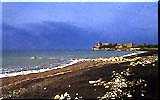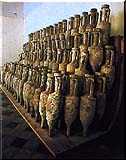|

Port
and navigation
The port represented an area of great economic dynamism and
cultural liveliness. Often, for reasons of defence, the cities
were not built on the coast but slightly inland. It was thus
that the most important cities had ports, for example Pyrgi
for Caere, which developed to the extent of becoming themselves
well-known and important centres. The ports, in addition to
receiving commercial and military traffic, were the gathering
point for a numerous fleet of small boats used by fishermen,
as the waters of the Etruscan coast were famous for the abundance
of fish to be caught there. In the first phase of their history,
the Etruscans were a sea-faring people respected in the whole
of the Mediterranean. Due to the lack of instrumentation and
the fragility of the vessels, which could not withstand storms,
navigation was as close as possible to the coast and only
during the day. At night, the cargo boats cast their anchors
in sheltered places, whilst the war galleys were hauled by
their crews on to the shore. The sailors of the period used
the stars and their knowledge of the conformation of the coasts
to guide them. Portolanos did exist but they were not commonly
used.

Maritime
trade
In ancient times, navigation represented the least costly
and safest method for the transport of goods and people. The
seas and navigable rivers were constantly plied by vessels
carrying every type of goods. As early as the 7th and 8th
centuries BC, the Etruscan merchants reached every part of
the Mediterranean in their ships. The typical products exported
were ceramics, in particular bucchero ware, and wine. The
cargo ships were squat and pot-bellied, with the keel at times
covered by a sheet of lead; the poop was high and curved,
the sail was square and attached to the central mast. They
used anchors of stone, and the ancients attributed their invention
to the Etruscans. To steer the boat, the helmsman used two
oars on the quarter-deck.

War
at sea
The warships, long and streamlined, moved forward by the force
of oarsmen in one or two rows and the wind was used as an
auxiliary driving force. The war galleys could be up to thirty
metres in length and in the most ancient times they had no
bridge; later, they had an upper bridge for the sailors and
soldiers. A rostrum was inserted on the prow which skimmed
the surface of the water. This was used in fighting to ram
enemy galleys. At sea, the combat technique was that of manoeuvres
and ramming. Success therefore depended on the skill of the
crews and the strength of the oarsmen. When the vessels came
close together, there was a heavy launching of projectiles,
at times in flames; when the ships were side by side, the
crews tried to strike one another using long lances. There
was boarding and hand to hand fighting when contingents of
foot soldiers were on board and when the aim was to capture
an enemy ship and its cargo. During the winter, naval operations
were suspended, but the disaster of entire fleets destroyed
by a storm was not infrequent.
|



